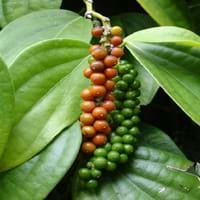Life Span
Perennial
Perennial
Type
Fruit, Tree
Broadleaf Evergreen, Vines
Origin
Not Available
India, Indonesia, Southeast Asia, Southern Asia
Types
Not Available
Red pepper, Orange pepper
Number of Varieties
Not Available
Habitat
Forests, gardens, Hill prairies, Homesteads, Rocky areas, Woodlands
Moist Soils, orchards, Temperate Regions
USDA Hardiness Zone
Not Available
8-15
AHS Heat Zone
Not Available
12 - 1
Sunset Zone
Not Available
H1, H2, 8, 9, 14, 15, 16, 17, 18, 19, 20, 21, 22, 23, 24
Habit
Bushy, Evergreen
Clump-Forming
Minimum Width
Not Available
Flower Color
Light Green, Lime Green
Lemon yellow
Flower Color Modifier
Not Available
Bicolor
Fruit Color
Green, Light Green
Red, Green, Light Green
Leaf Color in Spring
Yellow, Green, Gray Green
Light Green, Dark Green
Leaf Color in Summer
Light Green
Light Green
Leaf Color in Fall
Yellow, Green, Gray Green
Light Green, Dark Green
Leaf Color in Winter
Yellow, Green, Gray Green
Light Green, Dark Green
Leaf Shape
Ovate
Circular cordate
Plant Season
Spring, Summer, Fall, Winter
Spring, Summer, Fall, Winter
Sunlight
Full Sun, Partial Sun, Partial shade
Full Sun, Partial Sun, Partial shade
Type of Soil
Loam, Sand
Loam, Sand
The pH of Soil
Acidic, Neutral, Alkaline
Acidic, Neutral, Alkaline
Soil Drainage
Well drained
Average
Bloom Time
Early Summer, Summer, Late Summer, Early Fall
Not Available
Tolerances
Pollution, Salt, Soil Compaction
Drought
Where to Plant?
Ground
Container, Ground
How to Plant?
Seedlings, Stem Cutting, Stem Planting
Seedlings, Stem Planting, Vegetative Reproduction
Plant Maintenance
Low
Medium
Watering Requirements
Keep ground moist, Requires regular watering, Use Mulches to help prevent water loss during hot and windy weather
Do Not over Water, Sprinkle water over foliage, Water every two or three days during warmer months
In Summer
Lots of watering
Lots of watering
In Spring
Moderate
Moderate
In Winter
Average Water
Average Water
Soil pH
Acidic, Neutral, Alkaline
Acidic, Neutral, Alkaline
Soil Type
Loam, Sand
Loam, Sand
Soil Drainage Capacity
Well drained
Average
Sun Exposure
Full Sun, Partial Sun, Partial shade
Full Sun, Partial Sun, Partial shade
Pruning
Cut or pinch the stems, Do not prune during shooting season, Remove deadheads
A hard prune may be necessary if the plant becomes woody, Remove dead branches, Trim each shoot back to the first set of leaves
Fertilizers
High Potash Fertilizer
10-10-10 diluted liquid fertilizer, All-Purpose Liquid Fertilizer, Do not let fertilizers touch the leaves
Pests and Diseases
Bacterial Blight, Foliage-feeding caterpillars, Moth
Aphids, Beetles, Root rot, Rust, Scab
Plant Tolerance
Pollution, Salt and Soil Compaction
Heat Tolerance, Humidity, Salt and Soil Compaction
Flowers
Showy
Not Available
Flower Petal Number
Single
Single
Foliage Texture
Fine
Medium
Foliage Sheen
Matte
Matte
Attracts
Caterpillar
Aphids, Leafminer, Snails, Squirrels
Allergy
Skin irritation
Oral Allergy
Aesthetic Uses
Not Used For Aesthetic Purpose
Beautification, Cottage Garden, Decorating walls
Beauty Benefits
Blood purifying, Glowing Skin, Good for skin and hair, Provides herbal hair care, Speed hair growth
Acne, Blackheads
Environmental Uses
Air purification, soil stabilisation
Fixes Nitrogen, Insect Repellent
Medicinal Uses
Atherosclerosis, Cancer, Diabetes, Diarrhea, High blood pressure, High cholestrol, Obesity, Vitamin C
Acid Reflux, Dysentry, Healthy teeth, Inflammation, Oral health
Part of Plant Used
Fruits
Dried seeds
Other Uses
Making Shampoo, Used for its medicinal properties, Used in herbal medicines
Culinary use, Oil is used for aromatherapy, Used in herbal medicines
Used As Indoor Plant
No
Yes
Used As Outdoor Plant
Yes
Yes
Garden Design
Cottage garden
Container, Feature Plant, Hedges, Screening / Wind Break, Tropical
Botanical Name
Phyllanthus emblica
Piper nigrum
Common Name
Indian Gooseberry, Amla , Awala
Peppercorn, Piper, Black pepper
In German
Stachelbeere
Pfeffer
In French
Groseille à maquereau
Piper nigrum
In Spanish
Grosella
Poivrier noir
In Greek
Φραγκοστάφυλλο
μαύρο πιπέρι
In Portuguese
Groselha
Pimenta-preta
In Polish
Agrest
Pieprz czarny
In Latin
hominem
nigrum piperis
Phylum
Magnoliophyta
Magnoliophyta
Class
Magnoliopsida
Magnoliopsida
Order
Malpighiales
Piperales
Family
Phyllanthaceae
Piperaceae
Clade
Angiosperms, Eudicots, Rosids
Angiosperms, Monocots
Tribe
Phyllantheae
Not Available
Subfamily
Not Available
Not Available
Number of Species
Not Available
Not Available
Season and Care of Indian Gooseberry and Black pepper
Season and care of Indian Gooseberry and Black pepper is important to know. While considering everything about Indian Gooseberry and Black pepper Care, growing season is an essential factor. Indian Gooseberry season is Spring, Summer, Fall and Winter and Black pepper season is Spring, Summer, Fall and Winter. The type of soil for Indian Gooseberry is Loam, Sand and for Black pepper is Loam, Sand while the PH of soil for Indian Gooseberry is Acidic, Neutral, Alkaline and for Black pepper is Acidic, Neutral, Alkaline.
Indian Gooseberry and Black pepper Physical Information
Indian Gooseberry and Black pepper physical information is very important for comparison. Indian Gooseberry height is 800.00 cm and width 400.00 cm whereas Black pepper height is 180.00 cm and width Not Available. The color specification of Indian Gooseberry and Black pepper are as follows:
Indian Gooseberry flower color: Light Green, Lime Green
Indian Gooseberry leaf color: Yellow, Green and Gray Green
Black pepper flower color: Lemon yellow
- Black pepper leaf color: Light Green and Dark Green
Care of Indian Gooseberry and Black pepper
Care of Indian Gooseberry and Black pepper include pruning, fertilizers, watering etc. Indian Gooseberry pruning is done Cut or pinch the stems, Do not prune during shooting season and Remove deadheads and Black pepper pruning is done A hard prune may be necessary if the plant becomes woody, Remove dead branches and Trim each shoot back to the first set of leaves. In summer Indian Gooseberry needs Lots of watering and in winter, it needs Average Water. Whereas, in summer Black pepper needs Lots of watering and in winter, it needs Average Water.





